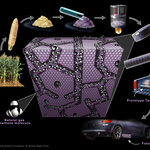Environment

Researchers at the Smithsonian Environmental Research Center report the results of a six-year experiment in which doubling the atmospheric greenhouse gas carbon dioxide (CO2) in a scrub oak ecosystem caused a reduction in carbon storage in the soil.
The scientists said this response suggests a limited capacity of Earth’s ecosystems to stabilize atmospheric CO2 and slow global warming. These findings add a new perspective and a measure of caution suggesting that elevated CO2, by altering microbial communities, may turn a potential carbon sink into a carbon source.
Previous studies have shown…

The French Intergovernmental Panel on Climate Change (IPPC, or GIEC in French) has just announced the conclusions of its 4th report, which restates that global warming has increased the average temperature by 0.74°C over the last century. However, there is very little information about some parts of the planet, such as central Asia. A new study by French researchers from the Laboratory of Glaciology and Geophysics of the Environment (LGGE, CNRS / Université Joseph Fourier, Grenoble, France) and the Laboratory of Sciences of the Cliamte and the Environment (LSCE / IPSL, CEA / CNRS /…

New research aimed at understanding the link between carbon dioxide emissions and climate change in boreal systems has found clear links between both Spring and Fall temperature changes and carbon uptake/loss. Dr Kevin Robert Gurney, assistant professor in the Earth & Atmospheric Science/Agronomy at Purdue University and Associate Director of the Purdue Climate Change Research Center, presented these results at the “Is a Warmer Arctic Adding Carbon Dioxide to the Atmosphere” session of American Association for the Advancement of Science meeting in San Francisco, CA on December 17th.
The…

Using corncob waste as a starting material, researchers have created carbon briquettes with complex nanopores capable of storing natural gas at an unprecedented density of 180 times their own volume and at one seventh the pressure of conventional natural gas tanks.
The breakthrough, announced today in Kansas City, Mo., is a significant step forward in the nationwide effort to fit more automobiles to run on methane, an abundant fuel that is domestically produced and cleaner burning than gasoline.
Researchers at the University of Missouri-Columbia and the Midwest Research Institute in Kansas…

A scientific panel revealed today that rising global demand for healthy seafood has exceeded wild capture fisheries' ability to provide all fish meals demanded by consumers. Aquaculture -- or the farming of seafood -- is helping to fill the gap between sustainable wild supplies and the public demand for seafood. Research unveiled at the AAAS Annual Meeting demonstrated the enormous potential for sustainable growth of healthy farmed seafood production, notably through advancements in feed efficiency and the ability to expand production in marine environments.
"At a time when heart disease…

In his Jan. 23 State of the Union address, President George Bush outlined his plan to reduce the nation's dependency on foreign oil by requiring the production of 35 billion gallons a year of renewable and alternative fuels by 2017, roughly five times the current target set by Congress of 7.5 billion gallons by 2012.
Among the most promising alternatives are fuels derived from biological material. Currently, the main biofuel used in the United States is ethanol distilled from kernels of corn. There are about 140 corn ethanol refineries nationwide, which produce more than 5 billion gallons a…

A new report on climate over the world's southernmost continent shows that temperatures during the late 20th century did not climb as had been predicted by many global climate models.
This comes soon after the latest report by the Intergovernmental Panel on Climate Change that strongly supports the conclusion that the Earth's climate as a whole is warming, largely due to human activity.
It also follows a similar finding from last summer by the same research group that showed no increase in precipitation over Antarctica in the last 50 years. Most models predict that both precipitation and…

Since the spring of 2005, scientists working for the Institute of Systems Biology and Ecology (ISBE) from the Czech Academy of Sciences have been focusing on research aimed at designing a physically-based algorithm to scale spectral and spatial data on vegetation, which is relevant to the development of the Sentinel-2 mission.
Map of total chlorophyll content (Cab)generated from the hyperspectral airborne AISA Eagle sensor (pixel-size 0.4 m) acquired in 2004 over Norwegian spruce at the Bily Kriz research site in the Czech Republic.
Credits: Institute of Systems Biology and Ecology (ISBE)…

Researchers from the University of Leicester and the British Geological Society (BGS) have proposed storing carbon dioxide in huge underground reservoirs as a way of reducing emissions- and have even identified sites in Western Europe that would be suitable.
Their research, published in the journal, Planet Earth, reveals that CO2 can be contained in cool geological aquifers or reservoirs, where it can remain harmlessly for many thousands of years.
PhD research student, Ameena Camps, is working with Professor Mike Lovell at the University's Department of Geology and with Chris Rochelle at BGS…

Researchers from the University of Leicester and the British Geological Society (BGS) have proposed storing carbon dioxide in huge underground reservoirs as a way of reducing emissions- and have even identified sites in Western Europe that would be suitable.
Their research, published in the journal, Planet Earth, reveals that CO2 can be contained in cool geological aquifers or reservoirs, where it can remain harmlessly for many thousands of years.
PhD research student, Ameena Camps, is working with Professor Mike Lovell at the University's Department of Geology and with Chris Rochelle at BGS…